P182 Special Edition - One of the best cases gets better
by Joshua Buss on April 12, 2007 1:00 AM EST- Posted in
- Cases/Cooling/PSUs
Interior
Inside, not much has changed through the various iterations of Antec's P18x series. Their design places the power supply at the bottom but does not invert the motherboard like other cases with this layout. Although sometimes this can make certain motherboard/power supply combinations impossible fits for the case, Antec believes it is still worthwhile it to have this layout, and for a few reasons it really does make sense.
Most notably, the design allows for all the hottest air that collects around the CPU and motherboard power regulators to be taken away very quickly by the two large exhaust fans placed at the top-rear of the case.
In this shot of the fan in the top plate, a USB-powered flexible work light is visible. When not in use, the light stores away in its holder. It's an interesting inclusion, but of course it's only useful if the system is powered on; this is generally not the case when people are working on the interior of their computer.
Unlike the P180 we reviewed earlier, the entire inside of the P182 SE is black - right down to the drive cages and motherboard mounting tray. To hold the hard drives, two separate removable cages are used. The top unit can contain two drives, each one in its own removable sled, and the bottom cage can hold four with vibration-dampening rubber grommets.
Each cage is guided securely in place along rails and held fast with a single thumbscrew. As for the power supply, it's held with a piece of metal with rubber along some of its edges that goes around three sides and then fastens with screws onto a platform underneath. Four more screws can go into the PSU itself in the back, regardless of which way the unit is oriented - a nice touch a lot of cheaper cases still have not implemented.
Our Zalman PSU's plethora of cables still all fit through the collapsible opening, but longer power supplies might require the removal of the fan in this bottom section. For the longest power supplies, the entire plate that the fan mounts onto can be taken out. The handy sliding cover serves to keep the cabling neat, and simultaneously it segregates the different airflow zones of the case; unfortunately it's still a bit flimsy in its construction and use. There are actually two holes in the cover, one for the power supply cables and one for cabling to go to the lower hard drive cage. Both can be opened and closed individually.
Inside, not much has changed through the various iterations of Antec's P18x series. Their design places the power supply at the bottom but does not invert the motherboard like other cases with this layout. Although sometimes this can make certain motherboard/power supply combinations impossible fits for the case, Antec believes it is still worthwhile it to have this layout, and for a few reasons it really does make sense.
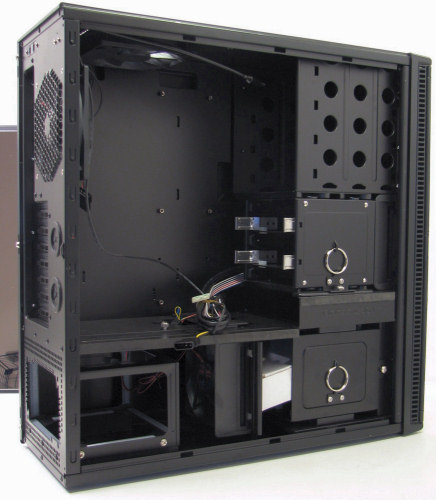 |
| Click to enlarge |
Most notably, the design allows for all the hottest air that collects around the CPU and motherboard power regulators to be taken away very quickly by the two large exhaust fans placed at the top-rear of the case.
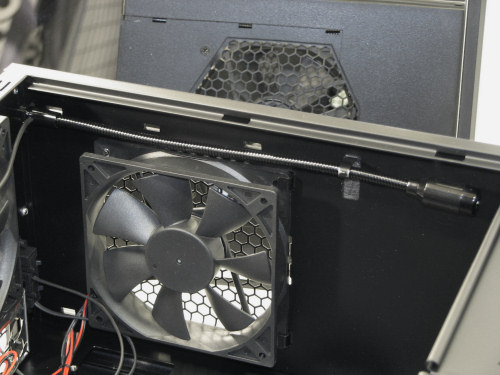 |
| Click to enlarge |
In this shot of the fan in the top plate, a USB-powered flexible work light is visible. When not in use, the light stores away in its holder. It's an interesting inclusion, but of course it's only useful if the system is powered on; this is generally not the case when people are working on the interior of their computer.
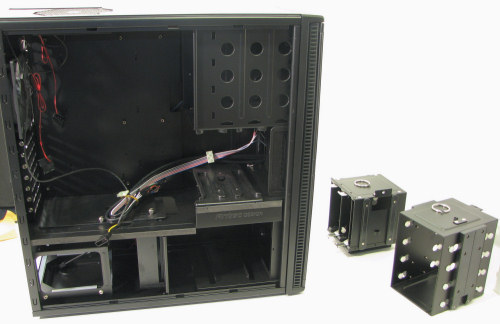 |
| Click to enlarge |
Unlike the P180 we reviewed earlier, the entire inside of the P182 SE is black - right down to the drive cages and motherboard mounting tray. To hold the hard drives, two separate removable cages are used. The top unit can contain two drives, each one in its own removable sled, and the bottom cage can hold four with vibration-dampening rubber grommets.
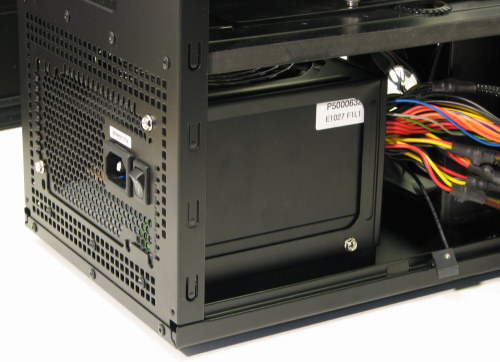 |
| Click to enlarge |
Each cage is guided securely in place along rails and held fast with a single thumbscrew. As for the power supply, it's held with a piece of metal with rubber along some of its edges that goes around three sides and then fastens with screws onto a platform underneath. Four more screws can go into the PSU itself in the back, regardless of which way the unit is oriented - a nice touch a lot of cheaper cases still have not implemented.
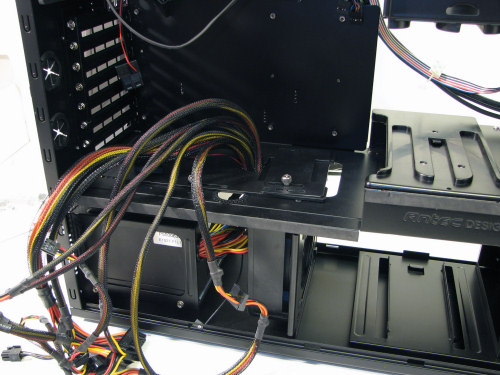 |
| Click to enlarge |
Our Zalman PSU's plethora of cables still all fit through the collapsible opening, but longer power supplies might require the removal of the fan in this bottom section. For the longest power supplies, the entire plate that the fan mounts onto can be taken out. The handy sliding cover serves to keep the cabling neat, and simultaneously it segregates the different airflow zones of the case; unfortunately it's still a bit flimsy in its construction and use. There are actually two holes in the cover, one for the power supply cables and one for cabling to go to the lower hard drive cage. Both can be opened and closed individually.










63 Comments
View All Comments
crimson117 - Thursday, April 12, 2007 - link
I believe a hole in your otherwise very well-done review is that you used a mATX board, which does not push the case's internal capacity to the limit.I have a P180 and use a regular ATX board (Asus A8V Deluxe), and let me tell you - it gets VERY crowded down at the bottom of the motherboard...
I have: power supply cabling coming up from the bottom, a PCI TV Tuner card installed in the lowest PCI slot, the front-panel case cables coming in to the motherboard port, and the lower hard disk's cables coming up to the motherboard.
It's very very crowded and difficult to work with.
I personally would not use a full sized board again with the P180; I'd find another classy case or just use a mATX board.
Johnspree - Saturday, December 26, 2009 - link
To all of you who wants to build a new pc with this Case, Antec P182. I got one my self and I think I have a lot of rooms to work with. All you have to do is run most of you cables thru the other side of the case.JoshuaBuss - Thursday, April 12, 2007 - link
Certainly in my experience this case has one of the best potentials for building the quietest PC possible..